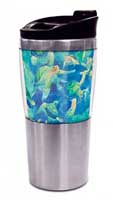
The Ocean
The oceans of the world cover more than 72% of the planet but humans have only explored 5% of it. We actual know more about space than the oceans on our planet. One of the reasons for this is that the average depth of the ocean is 12,205 feet deep. The deepest point is nearly 7 miles deep and is called the Challenger Deep and is located in the Mariana Trench near the Philippines. The largest restraint from exploring these deep waters is the pressure and humans inability to build a structure to withstand it. The pressure exerted on all things in the oceans depths can reach to 8 tons per square inch. With 85% of the ocean to be classified as Deep Ocean, it may never be fully explored. With light only able to penetrate up to 330 feet, most of the ocean is in darkness.
Tides are how the moon and sun both use their gravitational pull on the earth to influence matter here. While the average tide might be just a few feet, the largest one is located at the Bay of Fundy were the difference between low and high tide is over 53 feet.
The ocean is home to 94% of all life on the planet earth. There is enough water in all of the oceans to fill a 621 mile wide cube. The contents of the ocean have over 200 million tones of suspended material. This includes many different types of salts, minerals and gold. The oceans hold 97% of all water on earth. Less than 1% of the water on earth is considered fresh water, with the remaining 2% being other forms of water, like icebergs and glaciers.
The largest and longest mountain range is also located far beneath the oceans. It begins running down the middle of the Atlantic and runs for more than 35,000 miles into the Pacific and Indian Oceans. It is called the Mid Oceanic Ridge. In this ridge are hot vents that heat sea water to over 400 F. The Pacific Ocean is ringed by the largest concentration of active volcanoes in the world called, the Ring of Fire.
The Pacific Ocean is the largest covering 30% of the earth. The Atlantic is second covering 21% and the Indian Ocean is third, covering only 14% of the earth’s surface. See the image above, where Honu Sea Turtles are swimming on the side of a Travel Mug.
For those of you that have ever swallowed ocean water while playing in the sea, its interesting to know that in 1 mL of sea water, there are over 10 million viruses and 1 million bacteria. Despite this, the makeup of the ocean is closely associates with the contents of mammal blood. At times, sea water has also been used as a substitute for blood when blood or plasma was not available.
We will be exploring and finding many discoveries in the oceans in the years ahead.
by Douglas Gray
Back to the Articles menu page
Copyright © 2014 by Tropical Breeze Decor - may not be published without our permission
